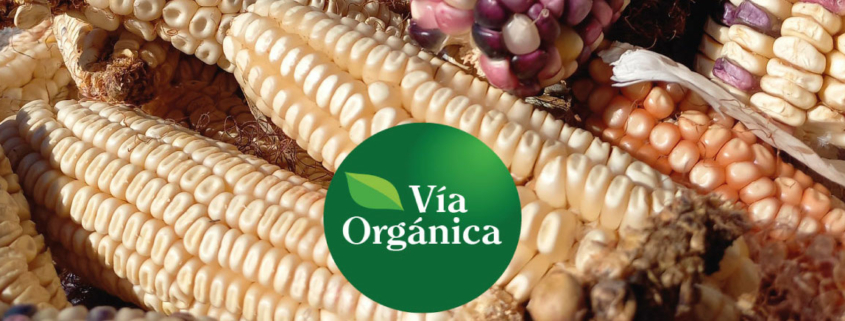Monthly Newsletter – Vía Orgánica
For organic regenerative agriculture, fair trade,
social justice, sustainable living and sustainable production
EDUCATIONAL RANCH VIA ORGÁNICA
Ranch news
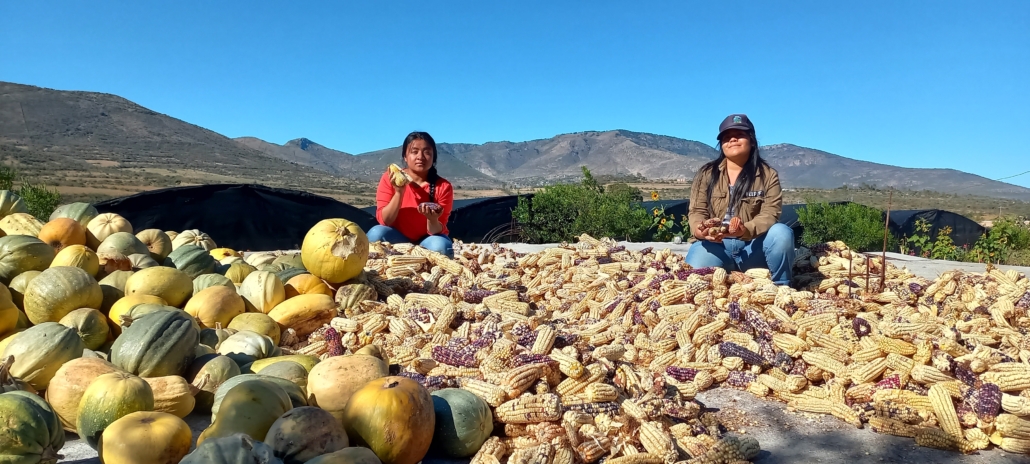
Corn and milpa at Rancho Vía Orgánica
In the Jalpa Valley, as in many landscapes in Mexico, you can see rainfed cornfields. This combination of corn, bay beans, green beans, pumpkins that look like they’re in a race to grow; the flowers of olives, sunflowers, thistles that house endless bees and other insects that dance around them; quelites, purslane, mallows and medicinal herbs that appear to grow and share at the same time and in the same place on earth a party called “LA MILPA”. The house of corn and its allies, which provide vast food, medicine and many benefits to the soil and biodiversity.
The people who work in the milpa are getting older, despite that, you can still see the corn and the milpa in their homes; and with it, the hope of achieving food sovereignty, staying in the territory, rescuing seeds and inheriting the knowledge of our ancestors.
Cultivating the milpa is a powerful act and this bulletin is dedicated on this occasion to all the families who are summoned to continue cultivating on their rainfed plots. Waiting for a good cycle of rains, waiting for the moon to sow or harvest, the first corn, squash flowers and milpa tomatillos, tiny and sweet.
Each rainy season is a challenge for the producers who store their corncobs from the last cycle, which were harvested with the moon to prevent them from getting holes, in addition, it is common for them to exchange seeds. In doing so, they select the maize plants that do best even in low rainfall. This is the greatest advantage of an open-pollinated seed that improves its production characteristics every year, adapts to the conditions and to each producer. For this reason, it is an important capital and tailored to each zone of the semi-arid landscape.
There is much to be done: let us consider that a native seed of corn, beans and squash with the manure added by the peasants produces on the plot with the water received in the season, what would become of that seed that already has a lot of potential and vigor if it gets complemented with beneficial microorganisms to make available the necessary nutrients and beneficial relationships. In addition, if we add a little worm humus leachate and if the grasshoppers join too, they can be tricked and eaten in a delicious nixtamalized tortilla taco with a molcajete sauce. The damaging effect of grasshoppers can be minimized with nejayote (water that results from the nixtamalization process) To help our milpa, if the cuttings are left on the milpa land with plant biomass as soil food, the result will be a stronger, and more productive cornfield, placed on soil capable to store more water and with higher fertility.
Cultivating has always been a laborious activity, but now it becomes a real challenge in the face of the climatic situation, even so, the wonders of growing corn and milpa in your home, are one of a kind.
This month we celebrate corn at home, the milpa, with special tours to discover the species that sprout on our plot, learn what they’re used for, and how plants are related. At the end of your tour ask for your cooked corn and some product from the milpa.
Billion Agave Project
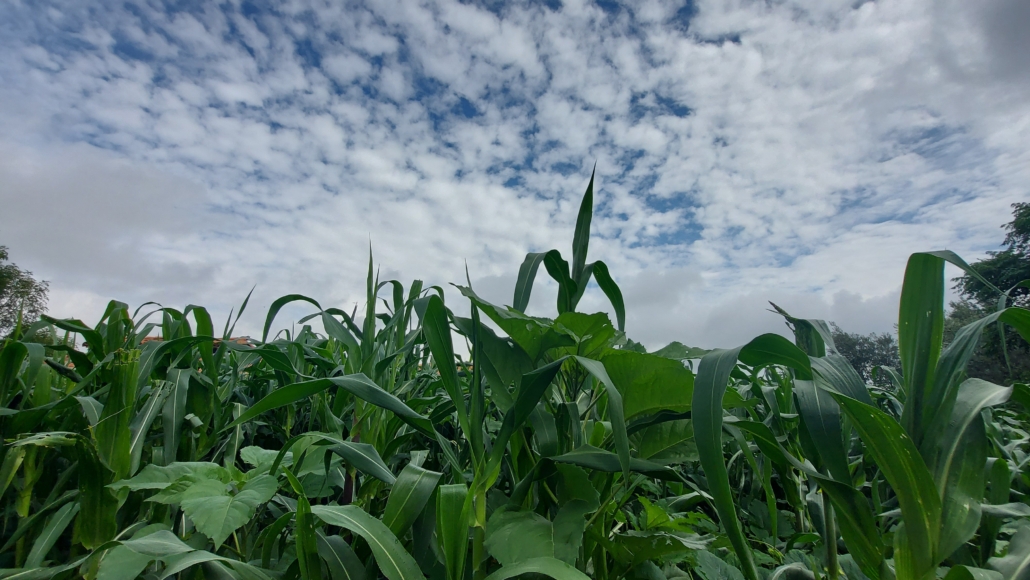
The milpa coexists with almost everything and in the semi-arid landscape, it gets along between rows of maguey and cactus. That is, surrounded by magueyes as living barriers. Also the pulque and aguamiel, product of the maguey, get along well during a day of farm work, in moderation, because it is a gift from the gods.
This rainy season, the magueyes are so noble that they make the most of the scarce rains received as well as every drop of dew at dawn, storing them in their leaves. They have a thick and waxy cuticle that prevents them from losing moisture. In addition, it is recommended to plant the maguey during these rainy months so that its roots cling to the ground and can be successfully grounded.
Taking advantage of the humidity, seeds of cover crops, grasses and flowers were added to the reforestation; more biomass that is used by wildlife, grazing goats and sheep, even bees take advantage of it.
We also removed the babies or shoots from the maguey plants and place them on the hillside of our water collection system. There are 7 species of magueyes that have been established in the ranch, the common types are the maguey cenizo, which seems to have powder, the jilote, known for its slow development, long life and high production of aguamiel. Another one is the mezcalero maguey or crassispina, it is not very big but it is very tough due to its hook-shaped spines; another one is the maguey pulquero or salmiana, which is the traditional one that we see of a large size and that is commonly cultivated. The smooth agave is an ornamental species, a bit ashy but beautiful, the striped agave or ornamental marginana gives a special spark and finally the berraco, known by the peasants and typical of the area, producers consider that it’s not good to make aguamiel or pulque, but it’s used for animal fodder during dry season.
SEASONAL CROP
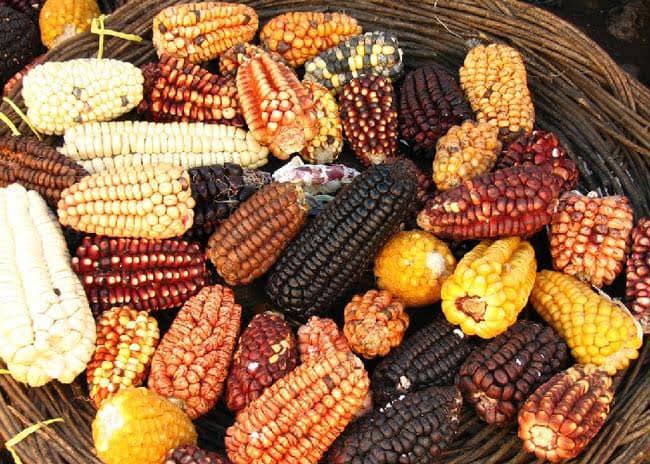
This cycle, the corn will arrive late if the rains continue, so this September, we began to cut squash blossoms, baby squash, green beans, and quelites.
Do it Yourself!
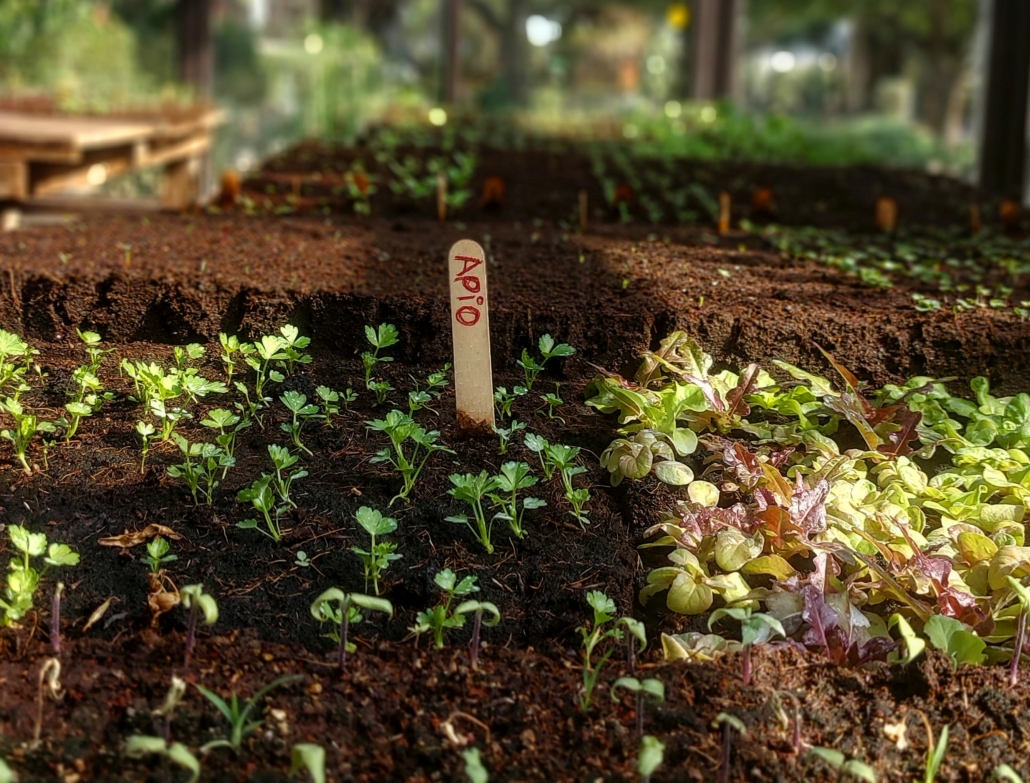
The best season for direct sowing is when the soil has moisture from the rain, so take advantage of this season and follow these simple steps:
Prepare a space in the garden to do your sowing, you can also fill a pot with prepared soil or a planter, just make sure the soil is loose and moist before planting.
INSTRUCTIONS
– Dig a small furrow an inch deep and plant carrot seeds, an easy growing crop that prefers direct shade.
– Open the second furrow to the previous depth, sow coriander seeds, another one of arugula and one more of lettuce mix.
– Cover each planted furrow and wait a few days, from the first week you will see the first leaves emerge.
You will harvest the carrot when it has formed, and for this you must remove one from the ground to verify. It will take approximately 60 days, on the other hand, you can harvest the cilantro by leaves along with the arugula and make a delicious pesto with sunflower seeds or a delicious salad accompanied by your lettuce mix that can be harvested when it is 4 inches tall.
Come and Visit
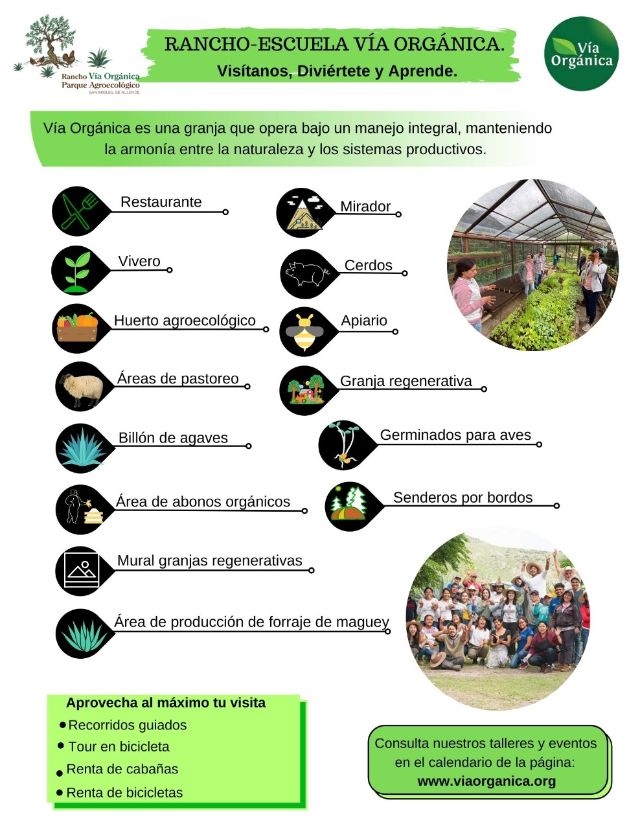
Cooking Time
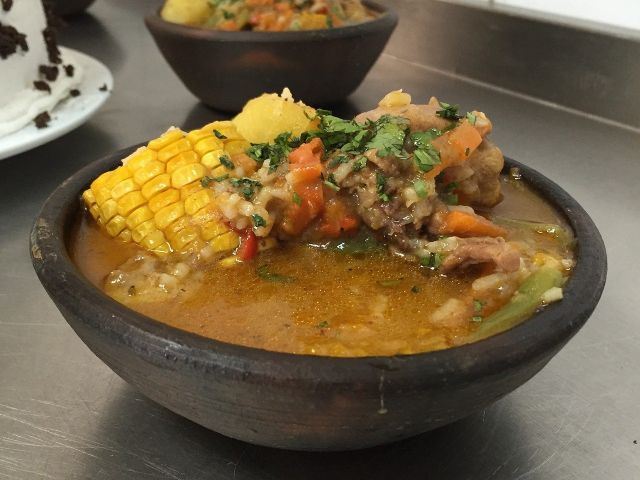
MILPA SOUP
INGREDIENTS
– 4 bunches of squash blossoms, cleaned and chopped
– 4 ears of corn, cleaned and shelled
– 3 jalapeño peppers, seeded and chopped
– 1 medium onion, finely chopped
– 1 garlic, finely chopped
– 1 bunch of epazote
– 2 liters of hot chicken broth
– Salt and oil to taste
INSTRUCTIONS
1. Heat a saucepan with oil, add the onion and fry for five minutes.
2. Add the garlic and corn kernels and cook for five more minutes.
3. Add salt and hot broth, cook for 20 min.
4. Add the peppers and continue cooking a little longer.
5. Add the flowers and the epazote, cook for 10 min.
6. Season to taste.
The soup needs to have a lot of liquid.
September Activities
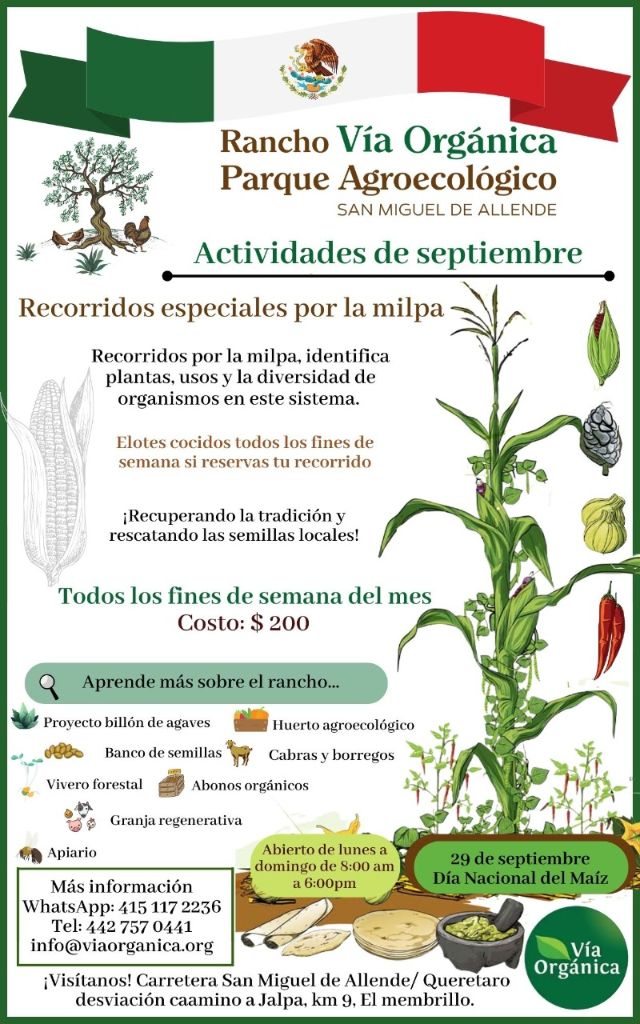
October Activities
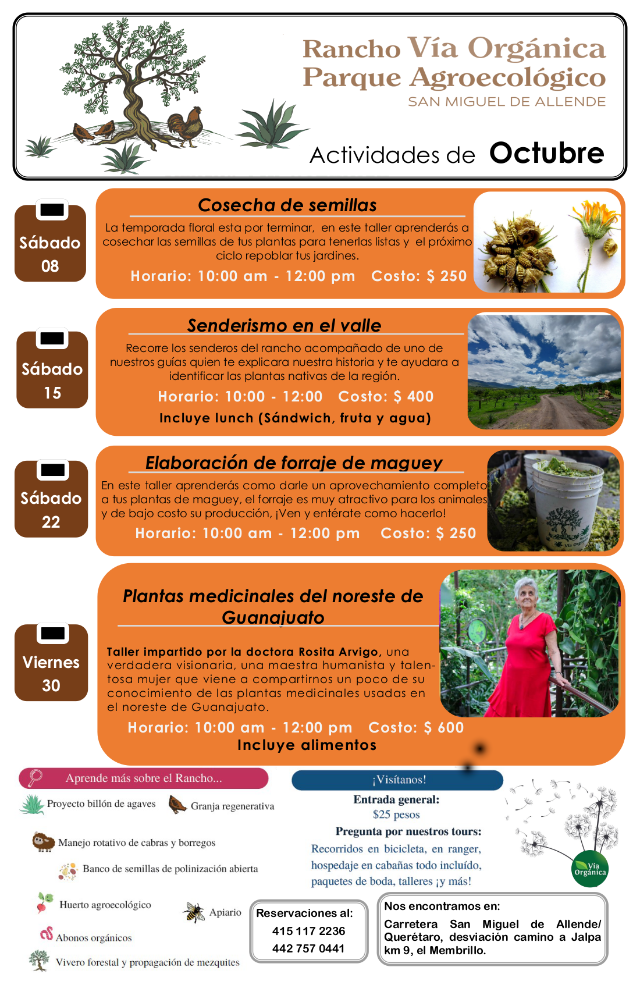
DON’T FORGET TO VISIT US!
Remember that we are open from 8 am to 6 pm
Carretera México/ Querétaro, deviation on the way to Jalpa, km 9
Agroecological Park Vía Orgánica.
For information on our products, seeds and harvest,
call our store at 442 757 0490.
Every Saturday and Sunday nixtamalized tortilla with Creole and local corn!
Enjoy our sweet and sour kale chips for children and not so children!

